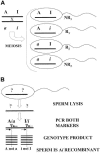Hot and cold spots of recombination in the human genome: the reason we should find them and how this can be achieved
- PMID: 12772086
- PMCID: PMC1180590
- DOI: 10.1086/376419
Hot and cold spots of recombination in the human genome: the reason we should find them and how this can be achieved
Figures




References
Electronic-Database Information
References
-
- Ardlie KG, Kruglyak L, Seielstad M (2002) Patterns of linkage disequilibrium in the human genome. Nat Rev Genet 3:299–309 - PubMed
-
- Badge RM, Yardley J, Jeffreys AJ, Armour JA (2000) Crossover breakpoint mapping identifies a subtelomeric hotspot for male meiotic recombination. Hum Mol Genet 9:1239–1244 - PubMed
Publication types
MeSH terms
LinkOut - more resources
Full Text Sources

